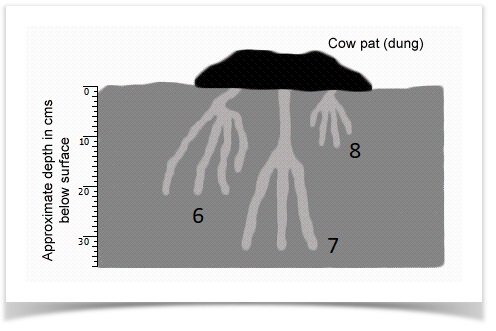DỊCH HOÀN THIỆN ĐỀ THI IELTS READING VÀ GIẢI THÍCH ĐÁP ÁN:
A Remarkable Beetle
Some of the most remarkable beetles are the dung beetles, which spend almost their whole lives eating and breeding in dung’. ĐOẠN 1
Một số loài bọ cánh cứng đáng chú ý nhất là bọ phân, chúng dành gần như cả đời để ăn và sinh sản trong phân'
More than 4,000 species of these remarkable creatures have evolved and adapted to the world’s different climates and the dung of its many animals. Australia’s native dung beetles are scrub and woodland dwellers, specialising in coarse marsupial droppings and avoiding the soft cattle dung in which bush flies and buffalo flies breed. ĐOẠN 2
Hơn 4.000 loài sinh vật đáng chú ý này đã tiến hóa và thích nghi với các vùng khí hậu khác nhau trên thế giới cũng như phân của nhiều loài động vật. Bọ phân bản địa của Úc là cư dân của cây bụi và rừng, quan tâm đặc biệt đến phân thô của thú có túi và tránh phân gia súc mềm, nơi ruồi bụi và ruồi trâu sinh sản.
In the early 1960s George Bornemissza, then a scientist at the Australian Government’s premier research organisation, the Commonwealth Scientific and Industrial Research Organisation (CSIRO), suggested that dung beetles should be introduced to Australia to control dung-breeding flies. Between 1968 and 1982, the CSIRO imported insects from about 50 different species of dung beetle, from Asia, Europe and Africa, aiming to match them to different climatic zones in Australia. Of the 26 species that are known to have become successfully integrated into the local environment, only one, an African species released in northern Australia, has reached its natural boundary. ĐOẠN 3
Vào đầu những năm 1960, George Bornemissza, khi đó là nhà khoa học tại tổ chức nghiên cứu hàng đầu của Chính phủ Úc, Tổ chức Nghiên cứu Công nghiệp và Khoa học Khối thịnh vượng chung (CSIRO), đã đề xuất rằng bọ phân nên được đưa vào Úc để kiểm soát ruồi sinh sản từ phân. Từ năm 1968 đến 1982, CSIRO đã nhập khẩu côn trùng từ khoảng 50 loài bọ phân khác nhau, từ Châu Á, Châu Âu và Châu Phi, nhằm mục đích làm cho chúng phù hợp với các vùng khí hậu khác nhau ở Úc. Trong số 26 loài được biết là đã hòa nhập thành công vào môi trường địa phương, chỉ có một loài, một loài châu Phi được thả ở miền bắc Australia, đã đạt đến ranh giới tự nhiên của nó.
Introducing dung beetles into a pasture is a simple process: approximately 1,500 beetles are released; a handful at a time, into fresh cow pats in the cow pasture. The beetles immediately disappear beneath the pats digging and tunnelling and, if they successfully adapt to their new environment, soon become a permanent, self-sustaining part of the local ecology. In time they multiply and within three or four years the benefits to the pasture are obvious. ĐOẠN 4
Đưa bọ phân vào đồng cỏ là một quá trình đơn giản: khoảng 1.500 con bọ được thả; từng ít một, vào những miếng phân bò tươi trên đồng cỏ dành cho bò. Những con bọ ngay lập tức biến mất bên dưới những bãi phân đang đào và đào hầm, và nếu chúng thích nghi thành công với môi trường mới, chúng sẽ sớm trở thành một phần lâu dài, tự duy trì của hệ sinh thái địa phương. Theo thời gian, chúng sẽ nhân lên và trong vòng ba hoặc bốn năm, lợi ích đối với đồng cỏ là hiển nhiên.
Dung beetles work from the inside of the pat so they are sheltered from predators such as birds and foxes. Most species burrow into the soil and bury dung in tunnels directly underneath the pats, which are hollowed out from within. Some large species originating from France excavate tunnels to a depth of approximately 30 cm below the dung pat. These beetles make sausage-shaped brood chambers along the tunnels. The shallowest tunnels belong to a much smaller Spanish species that buries dung in chambers that hang like fruit from the branches of a pear tree. South African beetles dig narrow tunnels of approximately 20 cm below the surface of the pat. Some surface-dwelling beetles, including a South African species, cut perfectly-shaped balls from the pat, which are rolled away and attached to the bases of plants. ĐOẠN 5

1. Mua bộ đề gần 400 bài ielts reading - Dịch và giải chi tiết Chỉ 199k bao gồm toàn bộ đề trong bộ Cambridge ( từ bộ 1 -19) và nhiều đề thi thực tế ( xem danh sách 400 đề ielts reading tại đây). Xem bài mẫu tại đây, Bài mẫu 1, bài mẫu 2, bài mẫu 3. Giải đề bao gồm phần dịch bài đọc, dịch phần câu hỏi, giải thích chi tiết, ( chỉ có thể tải, in phần đề để luyện tập, phần giải chi tiết và dịch chỉ xem online).
>>>>>>> Đặc biệt tặng kèm Dịch và giải chi tiết bộ đề Ielts listening từ Cam 10-18 và tặng kèm hơn 300 đề Ielts thực tế ( không có lời giải chi tiết chỉ có đề và đáp án) ( khác với bộ 400 đề ở trên). Vui lòng điền thông tin theo form tại đây và thanh toán theo thông tin CK trong form.
2. Đặc biệt dành tặng 100 bạn hoàn thành buổi học thử miễn phí khóa học Ielts Speaking online 1 kèm 1, các bạn sẽ được tặng bộ đề 400k bài Ielts reading và bộ đề Ielts Listening bộ Cam từ 10-18 gồm bài dịch và giải chi tiết, giải thích từ vựng khó ( thời hạn sử dụng trong vòng 2 tháng). Xem thông tin khóa học Ielts Speaking online 1 kèm 1 và đăng ký học thử tại đây.
For maximum dung burial in spring, summer and autumn, farmers require a variety of species with overlapping periods of activity. In the cooler environments of the state of Victoria, the large French species (2.5 cms long) is matched with smaller (half this size), temperate-climate Spanish species. The former are slow to recover from the winter cold and produce only one or two generations of offspring from late spring until autumn. The latter, which multiplies rapidly in early spring, produce two to five generations annually. The South African ball-rolling species, being a subtropical beetle, prefers the climate of northern and coastal New South Wales where it commonly works with the South African tunnelling species. In warmer climates, many species are active for longer periods of the year. ĐOẠN 6
Dung beetles were initially introduced in the late 1960s with a view to controlling buffalo flies by removing the dung within a day or two and so preventing flies from breeding. However, other benefits have become evident. Once the beetle larvae have finished pupation, the residue is a first-rate source of fertiliser. The tunnels abandoned by the beetles provide excellent aeration and water channels for root systems. In addition, when the new generation of beetles has left the nest the abandoned burrows are an attractive habitat for soil-enriching earthworms. The digested dung in these burrows is an excellent food supply for the earthworms, which decompose it further to provide essential soil nutrients. If it were not for the dung beetle, chemical fertiliser and dung would be washed by rain into streams and rivers before it could be absorbed into the hard earth, polluting water courses and causing blooms of blue-green algae. Without the beetles to dispose of the dung, cow pats would litter pastures making grass inedible to cattle and depriving the soil of sunlight. Australia’s 30 million cattle each produce 10-12 cow pats a day. This amounts to 1.7 billion tonnes a year, enough to smother about 110,000 sq km of pasture, half the area of Victoria. ĐOẠN 7
Dung beetles have become an integral part of the successful management of dairy farms in Australia over the past few decades. A number of species are available from the CSIRO or through a small number of private breeders, most of whom were entomologists with the CSIRO’s dung beetle unit who have taken their specialised knowledge of the insect and opened small businesses in direct competition with their former employer. ĐOẠN 8
Glossary
1. dung:- the droppings or excreta of animals
2. cow pats:- droppings of cows
Questions 1-5
Do the following statements reflect the claims of the writer in Reading Passage 6? In boxes 1-5 on your answer sheet write:
YES if the statement reflects the claims of the writer
NO if the statement contradicts the claims of the writer
NOT GIVEN if it is impossible to say what the writer thinks about this
1 Bush flies are easier to control than buffalo flies.
2 Four thousand species of dung beetle were initially brought to Australia by the CSIRO.
3 Dung beetles were brought to Australia by the CSIRO over a fourteen-year period.
4 At least twenty-six of the introduced species have become established in Australia.
5 The dung beetles cause an immediate improvement to the quality of a cow pasture.
Questions 6-8
Label the tunnels on the diagram below. Choose your labels from the box below the diagram. Write your answers in boxes 6-8 on your answer sheet.
Write your answers in boxes 6-8 on your answer sheet.

|
Dung Beetle Types Spanish South African South African ball roller. |
Question 9-13
Complete the table below.
Choose NO MORE THAN THREE WORDS OR A NUMBER from Reading Passage 6 for each answer.
Write your answers in boxes 9—13 on your answer sheet.
|
Species |
Size |
Preferred Climate |
Complementary species |
Start of active period |
Number of generations per year |
|
French |
2.5 cm |
Cool |
Spanish |
Late spring |
1-2 |
|
Spanish |
1.25 cm |
9 |
|
10 |
1 |
|
South African ball roller |
|
12 |
13 |
|
|
ĐÁP ÁN, GIẢI CHI TIẾT và DỊCH HOÀN THIỆN ĐỀ THI IELTS READING:
A Remarkable Beetle
Questions 1-5
Do the following statements reflect the claims of the writer in Reading Passage 6? In boxes 1-5 on your answer sheet write:
YES if the statement reflects the claims of the writer
NO if the statement contradicts the claims of the writer
NOT GIVEN if it is impossible to say what the writer thinks about this
1.NG Bush flies are easier to control than buffalo flies.
Ruồi bụi dễ kiểm soát hơn ruồi trâu.
Giải thích: không có thông tin
2.F Four thousand species of dung beetle were initially brought to Australia by the CSIRO.
Bốn nghìn loài bọ hung ban đầu được CSIRO đưa đến Úc.
Giải thích: có 50 loài
Between 1968 and 1982, the CSIRO imported insects from about 50 different species of dung beetle, from Asia, Europe and Africa, aiming to match them to different climatic zones in Australia.
Questions 6-8
Label the tunnels on the diagram below. Choose your labels from the box below the diagram. Write your answers in boxes 6-8 on your answer sheet.
Write your answers in boxes 6-8 on your answer sheet.

6. South African
Giải thích: Đoạn 5
South African beetles dig narrow tunnels of approximately 20 cm below the surface of the pat.
7. French
Giải thích: Đoạn 5
Some large species originating from France excavate tunnels to a depth of approximately 30 cm below the dung pat. These beetles make sausage-shaped brood chambers along the tunnels.
8. Spanish
Giải thích: Đoạn 5
The shallowest tunnels belong to a much smaller Spanish species that buries dung in chambers that hang like fruit from the branches of a pear tree.
|
Dung Beetle Types Spanish South African native South African ball roller. |
Question 9-13
Complete the table below.
Choose NO MORE THAN THREE WORDS OR A NUMBER from Reading Passage 6 for each answer.
Write your answers in boxes 9—13 on your answer sheet.
|
Species |
Size |
Preferred Climate |
Complementary species |
Start of active period |
Number of generations per year |
|
French |
2.5 cm |
Cool |
Spanish |
Late spring |
1-2 |
|
Spanish |
1.25 cm |
(9) temperate |
|
(10) early spring |
(11) 2-5 |
|
South African ball roller |
|
(12) sub-tropical |
(13) African tunnelling species |
|
|
9. temperate
Giải thích: Đoạn 6
the large French species (2.5 cms long) is matched with smaller (half this size), temperate-climate Spanish species.
10. early spring
Giải thích:Đoạn 6
The latter, which multiplies rapidly in early spring, produce two to five generations annually.
Answer:
1. NOT GIVEN 2. NO 3. YES 4. YES 5. NO 6. South African 7. French 8. Spanish 9. temperate 10. early spring 11. two to five / 2-5 12. sub-tropical 13. South African tunneling/tunnelling/tunneler/tunneller

.png)

.jpg)




